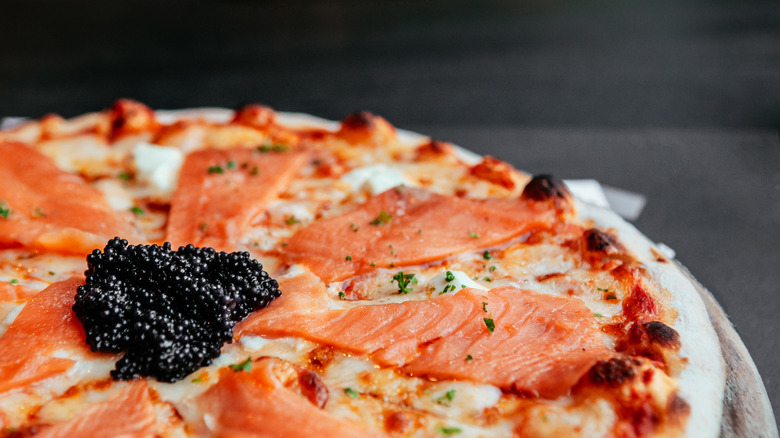The Food Revolution Behind Wolfgang Puck's Salmon Pizza
Every once in a while a new food movement takes the world by storm, changing the way chefs cook and the way people eat. Some examples include the Slow Food Movement, which basically is everything the fast-food movement is not, per Slow Food. Alice Waters is a notable name who is associated with the movement and its ideas of local ingredients, focus on preparation, and a helpful approach to what you eat, per PBS. Another movement is molecular gastronomy, made famous by such chefs as Ferran Adriá and Grant Achatz. This style of food includes edible foams and "fruits" that are actually meats, all achieved by science, per SciTechConnect.
Austrian-born chef and restaurateur Wolfgang Puck began his culinary career working in some of France's most renowned restaurants when he was just 14 years old, according to California Museum. He took his formal French training with him when he came to the United States, but by the time he landed in Los Angeles in 1975, Puck wasn't interested in a career based in classic French cuisine. Instead, he focused on what was right in front of his eyes, eventually becoming a pioneer of a food movement that changed dining forever.
Puck's smoked salmon pizza, created at Spago Beverly Hills in 1982, will forever be linked with this movement. Michelin Guide says the dish became so iconic and beloved that it continues to be served at the annual Governor's Ball, the hottest ticket in town following the Oscars.
A nod to the Golden State
According to Wine History Project, Puck took a good long look at the Los Angeles area for inspiration in what he wanted to achieve. He explored neighborhoods of all ethnicities, ate their cuisines, and shopped at local markets. What came of his research was not only a string of very successful restaurants, but a driving force behind California Cuisine. To be clear, he did not invent the movement, which may have began as early as the California Gold Rush, per MasterClass. Puck simply shed light on the style of cooking, which features fresh, local, seasonal ingredients, fusions of international cuisines, uncomplicated preparation and presentation, and an emphasis, not on the dish itself, but on the chef's interpretation of it.
What the movement also did was give credit to those previously unmentioned like winemakers, farmers, cheesemakers, and those who raised livestock, per Wine History Project. Puck's dishes and practices, which included open kitchens that allowed diners to watch their food being prepared, became a sensation in the food world, with many chefs worldwide following his lead, per Michelin Guide.
Without California Cuisine, we may not have ever experienced dishes such as California rolls, Chinese chicken salad, cioppino, and gourmet pizza with toppings like goat cheese, sun dried tomatoes, and (of course) smoked salmon.

